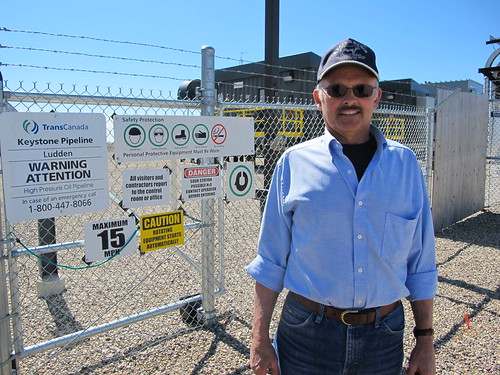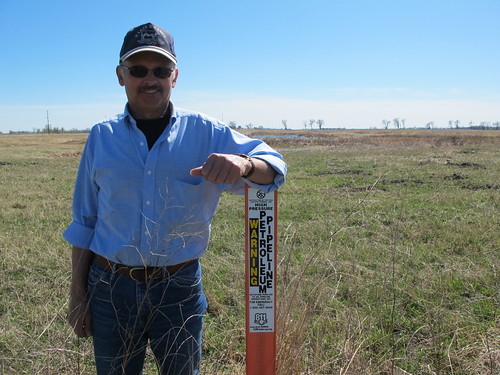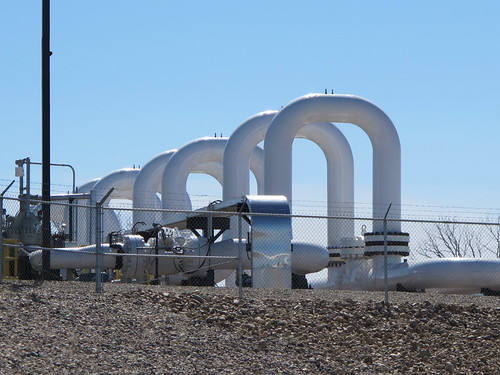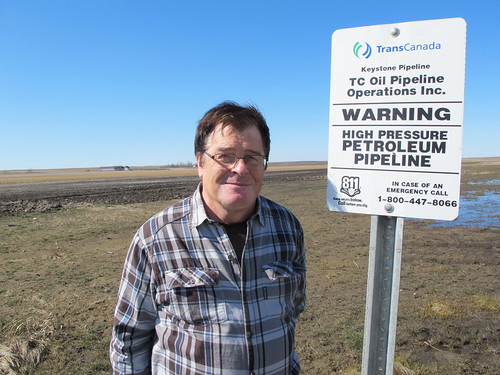Page added on June 30, 2012
Keystone Accident: A Geyser of Tar Sands Oil
On an early morning in May 2011, North Dakota farmer Bob Banderet was walking out of his farm house with his daughter to check on some calves when off in the distance they noticed something billowing into the air “like a geyser.” It didn’t take long for him to figure out what it was, since the plume of dark liquid shooting straight into the sky came from the newly-built Ludden Pumping Station, part of the new 1,300 mile Keystone 1 pipeline system that oil giant TransCanada had built a little over a mile from his house.
Banderet quickly called the pipeline operators who then shut it down, but not before 21,000 gallons of Canadian crude had spewed out of the pumping station. “It was just like the movies you used to see as a kid, when they’d strike oil and the geyser of oil shooting straight up in the air, with the plume on top.”
The tar sands blowout that Banderet witnessed is particularly relevant today, as the U.S. Army Corps of Engineers has just given TransCanada the green light to begin construction of portions of the “southern leg” of the controversial Keystone XL pipeline to the Gulf, where much of the heavy crude will be refined and exported. As NRDC’s Susan Casey-Lefkowitz has blogged, pushing a massive tar sands pipeline project to the Gulf over the objections of landowners is both foolhardy and dangerous for future generations.
It is downright foolhardy to cut corners on safety reviews for permitting the southern segment of the Keystone XL pipeline – that will carry costly and dirty tar sands from Canada. We already know from experience that tar sands oil is more likely to spill and harder to clean up once it spills. And to fight climate change, we need to reduce our dependence on oil. The people of Oklahoma, Texas and the rest of the country deserve better.
But up in the Dakotas, where the State Department is currently evaluating TransCanada’s new application to build the cross-border section of the $7 billion Keystone XL pipeline, landowners like Bob Banderet are worried about oil gushing through pipelines near their property today. The spill near Cogswell, ND, occurred at one of dozens of pumping stations that TransCanada constructed along its Keystone 1 pipeline, which each day pumps millions of gallons of tar sands oil from Canada through seven states to refineries in Oklahoma and Illinois. When Keystone 1 was completed in 2010, TransCanada proclaimed it used the safest pipeline technology in the world.
But those boasts now prove hard for some to believe. Within the first year of operation, the Keystone 1 pipeline had more than a dozen spills. A month after Banderet witnessed the North Dakota accident, federal pipeline safety officials issued a corrective action order that shut the Keystone 1 pipeline down after a second pumping station spilled tar sands oil in Kansas. TransCanada complied with the safety order to inspect critical pipeline equipment, then quickly restarted the Keystone 1 pipeline in June, 2011.
For farmers like Banderet, the Keystone 1 pipeline spill is a cautionary tale of potential accidents to come if TransCanada is allowed to build its $7 billion Keystone XL pipeline, which would transport a river of tar sands oil from Canada all the way to refineries in the Gulf for processing—and export. Here’s how NRDC’s Anthony Swift blogged about the dangers of the Keystone 1 pipeline:
Let’s remember, TransCanada claimed that the Keystone I pipeline system would be one that would “meet or exceed world-class safety and environmental standards” and leak an average of 1.4 times a decade. In just its first year of operation, Keystone leaked fourteen times, a hundred times more leaks that TransCanada predicted. On its Canadian side, the pipeline has leaked at least twenty-one times.
The safety issues on Keystone I are consistent with the story of Mike Klink, a former TransCanada quality control inspector who worked on that pipeline. During his time with TransCanada, Mr. Klink reported systematic shortcuts that were taken in the construction of Keystone I which compromised its safety – including the use of inferior materials, haphazard methods and faked safety tests.



Bob Banderet near the Ludden Pumping Station. Photos: Rocky Kistner/NRDC
Tar sands oil also is heavier and more difficult to transport in pipelines than regular oil, since the thick Canadian crude needs to be cut with chemicals, then heated and piped at higher temperatures and pressures. So it’s not surprising there are more leaks and accidents involving tar sands oil that conventional crude. Just look at the recent spate of tar sands oil spills in Canada, where over a million liters of tar sands oil has leaked from pipelines in recent months, threatening pristine drinking water sources and wildlife.
But in the US, farmers and ranchers are equally concerned about toxic tars sands oil getting into major drinking water supplies like the Ogallala Aquifer, one of the world’s most important fresh water sources that rises to the surface in some areas of the Dakotas and Nebraska.
For ranchers and farmers in North Dakota, the tar sands pipeline safety record speaks for itself. Paul Matthews, a neighbor of Bob Banderet’s in southeastern North Dakota, built a house that now is just a half mile from the Keystone 1 pipeline. TransCanada bulldozed through his property a few years ago to lay the pipeline that he sees out his window every day.
“It’s a constant reminder to have this kind of threat around us,” Matthews says. “Every time I draw a glass of water from my sink, I don’t know if it’s still clean. I don’t know if I go to bed at night if a catastrophe could ignite… You just don’t know those things. But with the powers of eminent domain, it was forced upon me.”

Paul Matthews and the Keystone pipeline near his home. Photo: Rocky Kistner/NRDC
Matthews and Banderet say they have tried to get more information from local and federal officials about the pumping station accident, as well as information about ongoing pipeline monitoring programs. Instead they say they have been stonewalled. “I’ve never heard from any of the federal agencies investigating these leaks,” Banderet says. “It seems they don’t want to hear the other side….It seems like they want to keep it out of sight and out of mind until everyone forgets…I feel like a lost voice in the wilderness.”
Voices of landowners like Banderet and Matthews need to be listened to in Washington, where politicians are besieged by deep-pocketed Big Oil lobbyists. But out on the front lines, farmers and ranchers know the real hazards associated with tar sands pipelines. And they aren’t about to be steamrolled until their voices are heard.
4 Comments on "Keystone Accident: A Geyser of Tar Sands Oil"


BillT on Sat, 30th Jun 2012 2:04 pm
We are the only animal that pollutes our own nest. And the only purpose is greed.
armaggedon51 on Sat, 30th Jun 2012 5:08 pm
I feel sorry for those folks near the front-line of this massive disaster that is the oil sands. I am afraid that those poor people are being rolled over by the big corporations and bought-off governments. I am Canadian and I am ashamed of this company attitude but still why in hell are Americans letting themselves being bullied by a Canadian corporation? Get together please and kick those guys out of your country.
DC on Sat, 30th Jun 2012 6:33 pm
Arma, is TCP even Canadian owned? I have done extensive searches on web to try to find out just *who* actually owns Trans-Canada, with little success. Maybe I am looking in the wrong places. And you well know, the Tar-sands is owned lock-stock and barrel by amerikan oil-firms, not Canadian. There is little, if any national controlling interesting, or even control, in Canadian energy by any level of govt.
MrEnergyCzar on Sat, 30th Jun 2012 10:48 pm
Why do we want very expensive tar oil brought into our country? Doesn’t that raise our average WTI price?
MrEnergyCzar